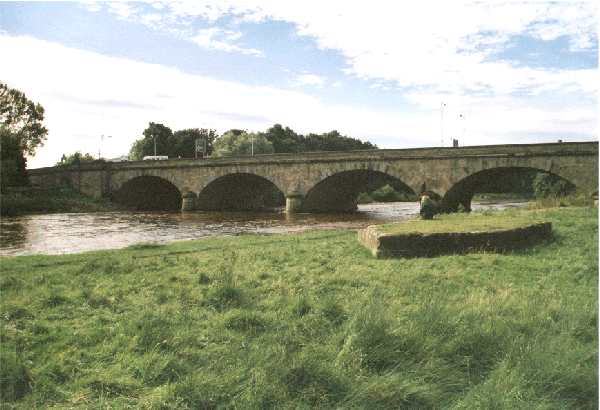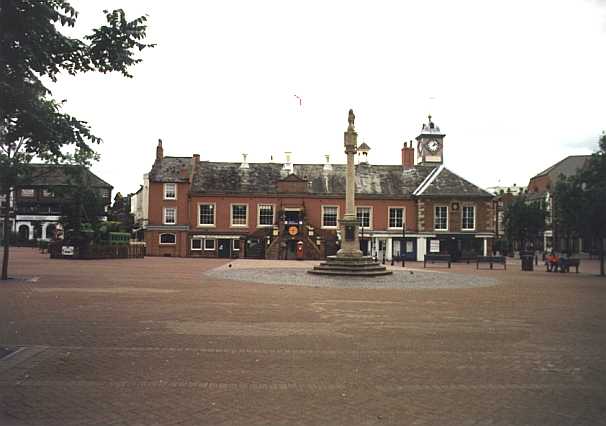 Bridges. - Formerly, the river
Eden, between Rickergate and Stanwix, divided itself into two branches, which were crossed
by two wooden structures called Eden and Priestbeck bridges, but being in a state of decay
were taken down in 1600, when two narrow stone bridges, were erected in their stead. In
1812, the present noble and extensive bridge over the Eden, was commenced under the
provisions of an Act of Parliament, passed in 1807, and was completed in 1815, at an
expense of £70,000, towards which government advanced £10,000 on account of its being on
the direction of the new road, then being formed to Port Patrick and Glasgow. The entire
length of this elegant free-stone bridge, is 400 yards, and its breadth, within the
parapets, 12 yards, having a flagged pavement on each side of the carriage way for foot
passengers. It consists of five elliptical arches, each 65 feet span; the piers and
abutments are founded on solid rock, 10 or 12 feet below the surface of the water; and the
stones for all the principal parts of the structure, were brought from the cove,
near Gretna, in Scotland. It was erected from designs, and under the superintendence of
Robert Smirke, Jun., Esq. R. A.
Bridges. - Formerly, the river
Eden, between Rickergate and Stanwix, divided itself into two branches, which were crossed
by two wooden structures called Eden and Priestbeck bridges, but being in a state of decay
were taken down in 1600, when two narrow stone bridges, were erected in their stead. In
1812, the present noble and extensive bridge over the Eden, was commenced under the
provisions of an Act of Parliament, passed in 1807, and was completed in 1815, at an
expense of £70,000, towards which government advanced £10,000 on account of its being on
the direction of the new road, then being formed to Port Patrick and Glasgow. The entire
length of this elegant free-stone bridge, is 400 yards, and its breadth, within the
parapets, 12 yards, having a flagged pavement on each side of the carriage way for foot
passengers. It consists of five elliptical arches, each 65 feet span; the piers and
abutments are founded on solid rock, 10 or 12 feet below the surface of the water; and the
stones for all the principal parts of the structure, were brought from the cove,
near Gretna, in Scotland. It was erected from designs, and under the superintendence of
Robert Smirke, Jun., Esq. R. A.
Markets and Fairs. - The market days are Wednesday and Saturday, when the city is crowded with country people and farmers' carts, and is abundantly supplied with corn, and all kinds of provisions. Fairs, for the sale of cattle, and hiring of servants, are held here on the nearest Saturdays to Whitsuntide and Martinmas. Fairs are also held on the 26th of August, and continues a fortnight, and on the 19th of September; and during these two latter fairs, all persons are free from executions issued by the borough court. A series of fairs or "great marts" for horses and cattle, commence on the Saturday after the 10th of October, and continue till Christmas. There is an annual show of cattle, &c. in the large cattle market, formed upon the sands, near Eden bridge, when prizes are distributed by the Agricultural Society, for the purpose of encouraging cultivation, and the breed of stock, &c. &c.
Shambles. - These consist of two rows of
butchers' shops, extending from Scotch-street to Fisher-street, and were built by the
corporation, who, in 1790, purchased and took down the old shambles, which stood in the
Market-place, and were formed of wood, covered with different kinds of slate, which gave
them a grotesque and antique appearance. The building upon pillars, near the old shambles,
called Carnaby's Foley, was taken down at the same time, and the Main Guard,
situated in the market-place, was subsequently removed, and it is to be hoped that the old
buildings, adjoining the market-house will also be soon swept away, as their removal would
much improve the general appearance of the market-place.3
The site of the Main Guard is now converted into a commodious fish market; and
the Market-place is adorned with a stone market cross, consisting of a Grecian
Ionic column, with a plain shaft and pedestal, and it rises from the centre of a flight of
circular steps. The pillar is surmounted by a square block of masonry, presenting four
faces, which are used as sun dials; and on the top is a lion, bearing the corporation arms, and
resting one of its paws on a large folio, alluding either to Magna Charta, or the
city charter. It was erected in 1682. Mr. Robert Bendle is corn inspector for
Carlisle, and the office of inspector of weights and measures, for Cumberland, is
now vacant, The Main Guard was a large square building, with two small turrets,
of a triangular form, projecting from the angles of its east front, and having heavy
pyramidal roofs. It had on its front the date 1645, the year in which Carlisle was
surrendered to general Lesley.
lion, bearing the corporation arms, and
resting one of its paws on a large folio, alluding either to Magna Charta, or the
city charter. It was erected in 1682. Mr. Robert Bendle is corn inspector for
Carlisle, and the office of inspector of weights and measures, for Cumberland, is
now vacant, The Main Guard was a large square building, with two small turrets,
of a triangular form, projecting from the angles of its east front, and having heavy
pyramidal roofs. It had on its front the date 1645, the year in which Carlisle was
surrendered to general Lesley.
The Town Hall and Council Chamber, where the corporation and the mayor's court and city sessions are held, is an ancient building at the north end of the market-place, and is entered by a flight of double steps; the ground floor being occupied as retail shops, held of the corporation as a cullery tenure.4 Above the mayor's seat are suspended four old paintings, three of which are portraits of William and Mary, and Charles Howard, earl of Carlisle. In the passage leading to the council chamber, stands the ancient city chest, which is formed of oak, covered with strong ribs of iron, and secured by five padlocks. At the east end of the court is a more modern erection, containing the council chamber, and other corporation offices; and surmounted by a cupola, in which is a clock, now undergoing extensive repairs, with four dials, three of which are illuminated as night for the convenience of the inhabitants. In the magistrates' court or council chamber, behind the president's chair, is a full length oil painting of G.G. Mounsey, Esq., purchased at a cost of £100 and placed here in 1836, in commemoration of that gentleman, being the first municipal mayor of the borough.
Mannix & Whellan, History, Gazetteer and Directory of Cumberland, 1847